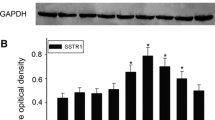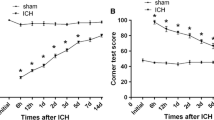Abstract
The insulin-like growth factor (IGF) system is linked to CNS pathological states. The functions of IGFs are modulated by a family of binding proteins termed insulin-like growth factor binding proteins (IGFBPs). Here, we demonstrate that IGFBP-6 may be associated with neuronal apoptosis in the processes of intracerebral hemorrhage (ICH). We obtained a significant upregulation of IGFBP-6 in neurons adjacent to the hematoma following ICH with the results of Western blot, immunohistochemistry, and immunofluorescence. Increasing IGFBP-6 level was found to be accompanied by the upregulation of Bax, Bcl-2, and active caspase-3. Besides, IGFBP-6 co-localized well with active caspase-3 in neurons, indicating its potential role in neuronal apoptosis. Knocking down IGFBP-6 by RNA-interference in PC12 cells reduced active caspase-3 expression. Thus, IGFBP-6 may play a role in promoting the brain secondary damage following ICH.






Similar content being viewed by others
References
Annunziata M, Granata R, Ghigo E (2011) The IGF system. Acta Diabetol 48:1–9. doi:10.1007/s00592-010-0227-z
Aronowski J, Zhao X (2011) Molecular pathophysiology of cerebral hemorrhage: secondary brain injury. Stroke 42:1781–1786. doi:10.1161/STROKEAHA.110.596718
Bach LA (2005) IGFBP-6 five years on; not so ‘forgotten’? Growth Horm IGF Res 15:185–192. doi:10.1016/j.ghir.2005.04.001
Behrouz R (2016) Re-exploring tumor necrosis factor alpha as a target for therapy in intracerebral hemorrhage. Transl Stroke Res. doi:10.1007/s12975-016-0446-x
Beilharz EJ et al (1998) Co-ordinated and cellular specific induction of the components of the IGF/IGFBP axis in the rat brain following hypoxic-ischemic injury. Brain Res Mol Brain Res 59:119–134
Chao W, D’Amore PA (2008) IGF2: epigenetic regulation and role in development and disease. Cytokine Growth Factor Rev 19:111–120. doi:10.1016/j.cytogfr.2008.01.005
Chen X, Shen J, Wang Y, Chen X, Yu S, Shi H, Huo K (2015) Up-regulation of c-Fos associated with neuronal apoptosis following intracerebral hemorrhage. Cell Mol Neurobiol 35:363–376. doi:10.1007/s10571-014-0132-z
Clemmons DR, Busby WH, Arai T, Nam TJ, Clarke JB, Jones JI, Ankrapp DK (1995) Role of insulin-like growth factor binding proteins in the control of IGF actions. Prog Growth Factor Res 6:357–366
Dyer AH, Vahdatpour C, Sanfeliu A, Tropea D (2016) The role of insulin-like growth factor 1 IGF-1 in brain development maturation and neuroplasticity. Neuroscience 325:89–99. doi:10.1016/j.neuroscience.2016.03.056
Fernandez AM, Torres-Aleman I (2012) The many faces of insulin-like peptide signalling in the brain Nature reviews. Neuroscience 13:225–239. doi:10.1038/nrn3209
Hammond MD et al (2014) CCR2+ Ly6C(hi) inflammatory monocyte recruitment exacerbates acute disability following intracerebral hemorrhage. J Neurosci 34:3901–3909. doi:10.1523/JNEUROSCI.4070-13.2014
Haramoto Y, Oshima T, Takahashi S, Ito Y (2014) Characterization of the insulin-like growth factor binding protein family in Xenopus tropicalis. Int J Dev Biol 58:705–711. doi:10.1387/ijdb.150032yi
Karabiyikoglu M, Hua Y, Keep RF, Ennis SR, Xi G (2004) Intracerebral hirudin injection attenuates ischemic damage and neurologic deficits without altering local cerebral blood flow. J Cereb Blood Flow Metab 24:159–166. doi:10.1097/01.WCB.0000100062.36077.84
Ke K et al (2015) Up-regulation of Glis2 involves in neuronal apoptosis after intracerebral hemorrhage in adult rats. Cell Mol Neurobiol 35:345–354. doi:10.1007/s10571-014-0130-1
Kessler SM, Haybaeck J, Kiemer AK (2016) Insulin-like growth factor 2—the oncogene and its accomplices. Curr Pharm Des 22(39):5948–5961
Konermann A, Lossdorfer S, Jager A, Chen Y, Gotz W (2013) Autoregulation of insulin-like growth factor 2 and insulin-like growth factor-binding protein 6 in periodontal ligament cells in vitro. Ann Anat 195:527–532. doi:10.1016/j.aanat.2013.10.001
Le Roith D, Bondy C, Yakar S, Liu JL, Butler A (2001) The somatomedin hypothesis. Endocr Rev 22:53–74. doi:10.1210/edrv.22.1.0419
Leclerc JL, Lampert AS, Diller MA, Immergluck JB, Dore S (2015) Prostaglandin E2 EP2 receptor deletion attenuates intracerebral hemorrhage-induced brain injury and improves functional recovery. ASN Neuro. doi:10.1177/1759091415578713
Li L et al (2013) Up-regulation of NFATc4 involves in neuronal apoptosis following intracerebral hemorrhage. Cell Mol Neurobiol 33:893–905. doi:10.1007/s10571-013-9955-2
Lioutas VA, Alfaro-Martinez F, Bedoya F, Chung CC, Pimentel DA, Novak V (2015) Intranasal insulin and insulin-like growth factor 1 as neuroprotectants in acute ischemic stroke. Transl Stroke Res 6:264–275. doi:10.1007/s12975-015-0409-7
Liu C et al (2016) Increased expression of ubiquitin-specific protease 4 participates in neuronal apoptosis after intracerebral hemorrhage in adult rats. Cell Mol Neurobiol. doi:10.1007/s10571-016-0375-y
Lund J, Sondergaard MT, Conover CA, Overgaard MT (2014) Heparin-binding mechanism of the IGF2/IGF-binding protein 2 complex. J Mol Endocrinol 52:345–355. doi:10.1530/JME-13-0184
Madathil SK, Saatman KE (2015) IGF-1/IGF-R signaling in traumatic brain injury. In: Kobeissy FH (ed) Brain neurotrauma: molecular, neuropsychological, and rehabilitation aspects. CRC Press/Taylor & Francis, Boca Raton, FL
Malandrakis EE et al (2016) DNA damage and differential gene expression associated with physical stress in gilthead seabream (Sparus aurata). Gen Comp Endocrinol. doi:10.1016/j.ygcen.2016.07.009
Mohan S, Baylink DJ (2002) IGF-binding proteins are multifunctional and act via IGF-dependent and -independent mechanisms. J Endocrinol 175:19–31
Raykha C, Crawford J, Gan BS, Fu P, Bach LA, O’Gorman DB (2013) IGF-II and IGFBP-6 regulate cellular contractility and proliferation in Dupuytren’s disease. Biochim Biophys Acta 1832:1511–1519. doi:10.1016/j.bbadis.2013.04.018
Shen J, Liu Y, Song Y, Li L, Duan C, Zhou Y, Ke K (2015) CHMP4B, ESCRT-III associating protein, associated with neuronal apoptosis following intracerebral hemorrhage. Brain Res 1597:1–13. doi:10.1016/j.brainres.2014.11.043
Strohbach C, Kleinman S, Linkhart T, Amaar Y, Chen ST, Mohan S, Strong D (2008) Potential involvement of the interaction between insulin-like growth factor binding protein (IGFBP)-6 and LIM mineralization protein (LMP)-1 in regulating osteoblast differentiation. J Cell Biochem 104:1890–1905. doi:10.1002/jcb.21761
Xi G, Keep RF, Hoff JT (2006) Mechanisms of brain injury after intracerebral haemorrhage. Lancet Neurol 5:53–63. doi:10.1016/S1474-4422(05)70283-0
Xu Z et al (2015) USP11, deubiquitinating enzyme, associated with neuronal apoptosis following intracerebral hemorrhage. J Mol Neurosci. doi:10.1007/s12031-015-0644-0
Authors’ Contributions
CD and LQ designed experiments; QD and PJ carried out experiments; YG, LZ, HD and ZY analyzed experimental results; HL analyzed sequencing data and developed analysis tools; XM wrote the manuscript.
Author information
Authors and Affiliations
Corresponding authors
Ethics declarations
Conflict of interest
The authors declare no conflict of interest.
Additional information
Qijun Dai and Peipei Jiang contributed equally to this work.
Electronic supplementary material
Below is the link to the electronic supplementary material.
10571_2016_453_MOESM1_ESM.tif
Fig. S1 Modulations of IGFBP-6 on cell apoptosis in vitro. Western blot showed siRNA-2 silenced IGFBP-6 in SH-SY5Y cells (A); the bar chart indicated the density of IGFBP-6 versus β-actin (B). The knockdown of IGFBP-6 induced decreasing levels of active caspase-3 and Bax and had up-regulation of Bcl-2 expression (C). The bar graph indicated the relative density of IGFBP-6, active caspase-3, Bax, and Bcl-2 versus β-actin (D). Data are presented as mean ± SEM. (n = 3, *, #, ^, & P < 0.05, significantly different from the control-siRNA-treated group). Immunofluorescent analysis of the colocalization between IGFBP-6 and active-caspase-3 in control, non-specific siRNA or IGFBP-6-siRNA-2 transfected SH-SY5Y cells after hemin treatment (E). Supplementary material 1 (TIFF 1704 kb)
Rights and permissions
About this article
Cite this article
Dai, Q., Jiang, P., Gu, Y. et al. Insulin-like Growth Factor Binding Protein6 Associated with Neuronal Apoptosis Following Intracerebral Hemorrhage in Rats. Cell Mol Neurobiol 37, 1207–1216 (2017). https://doi.org/10.1007/s10571-016-0453-1
Received:
Accepted:
Published:
Issue Date:
DOI: https://doi.org/10.1007/s10571-016-0453-1




